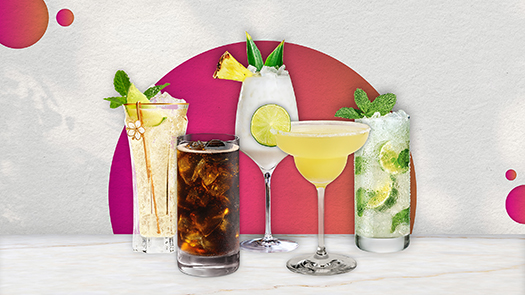150 Years of The Bacardi Archive Revealed
June 12, 2012
Bacardi shares rare look into archive to showcase 150-year rise of iconic rum brand from beginnings in Cuba to world’s favorite rum
Hamilton, Bermuda, June 12, 2012 — As part of its 150th anniversary celebration, Bacardi Limited shares an extraordinary glimpse into the unique heritage safeguarded in The Bacardi Archive of more than 150 years of precious documents, authentic historical assets and sometimes quirky artifacts about the Company, family and iconic brand. This rare look showcases the BACARDI® rum brand’s remarkable creation and international expansion to more than 150 markets to become the world’s favorite and most awarded rum with nearly 500 medals, as well as the rich history of the Company’s survival through adversities and critical success to become the world’s largest privately-held spirits company.
“The Bacardi Archive started with a shoe box of slides in 1998. The task to reconstruct our history was monumental because 98 years of assets were destroyed, scattered around the world with family members, or left when the Company’s Cuban assets were confiscated in 1960 by revolutionary forces,” says Bacardi Archivist Patty Suau. “In a little more than a decade, we have been able to re-acquire some of the most interesting pieces of our past. We have a remarkable heritage highlighted with creative marketing campaigns during the U.S. Prohibition era, a starring role in the ‘golden age of cocktails,’ and international growth while in exile after the Cuban Revolution ─ all under seven generations of family ownership.”
Fourteen years later and hundreds of thousands of hours of meticulous documentation, The Bacardi Archive houses more than 30,000 catalogued assets that date back as far as the 1850s – original documents from the founding of the Company, replicas of the original distillery and first Alembic still, early representations of the Bacardi bat logo, medals awarded since the 1870s for taste and quality, more than a century of newspaper articles, bat-themed jewelry from cuff links to necklaces, decades of broadcast and print ads, one-of-a-kind promotional items including pins and coasters, Prohibition-era branded glassware, antique BACARDI rum bottles, a collection of limited-edition blends for special occasions such as the turn of the millennium, and an extensive Latin American art collection, among other precious items.
“We have an amazing heritage that tells the story of a pioneering spirit that not only defines, but helped create a cocktail culture that began with my great-great grandfather in 1862 in Santiago de Cuba,” says Facundo L. Bacardi, Chairman of Bacardi Limited and a fifth generation Bacardi family member. “The Bacardi Archive captures our heritage and offers a connection to the resilient spirit of the Bacardí family, the Company, and the world-favorite BACARDI rum.”
The Bacardi story has its humble beginnings in Cuba where founder Don Facundo Bacardí Massó pioneered techniques such as the use of superior quality sugarcane molasses and the isolation of a strain of yeast for controlled fermentation and flavor consistency. He purposefully filtered, mellowed and blended rums to deliver specific flavors, aromas and smoothness – resulting in rum as we know it today. As a light-bodied, mixable rum, BACARDI inspired many of the world’s favorite cocktail recipes including the Cuba Libre, the Daiquirí, the Mojito and the Piña Colada.
“From our founding in Cuba to now being the third-largest international spirits company in the world, Bacardi has an incredible history and authenticity that connects directly with consumers around the world,” says Ed Shirley, President and CEO of Bacardi Limited. “We remain committed to our heritage as for the past 150 years Bacardi has fostered a dynamic culture of passion, excellence and an entrepreneurial spirit with the goal to create great-tasting cocktails. When a consumer asks for BACARDI rum, they know they are getting a quality drink with a great story backed by a family name and unwavering commitment to innovation, excellence and authenticity.”
The Bacardi Archive provides snapshots in time of the growth and perseverance of both the Company and its namesake brand. Some of the artifacts in The Bacardi Archive include:
Antiquarian Cocktail Book Collection
Nearly 600 rare antique reference and cocktail books written in English, Spanish, French, Dutch and German fill its shelves. Visiting mixologists often refer to such classics as How to Mix Drinks or The Bon Vivant’s Companion by “the father of American mixology” Jerry Thomas, published in 1862, the year BACARDI rum was created, as well as one of the earliest known recorded recipes to specify the use of BACARDI rum for the Mojito cocktail in La Ley Mojada (The Wet Law).
“Some of the rarest and most interesting books on the fine art of cocktail-making can be found in The Bacardi Archive. Many of these historic books feature recipes that call specifically for BACARDI rum, such as in the coveted Manual del Cantineros (Bartenders Guide), a cocktail recipe book created by the most respected barmen in Havana to raise the standards of cocktail-making in the 1920s. It has an entire section of BACARDI rum recipes as BACARDI inspired many of the classics we drink to this day,” adds Brand Master for BACARDI rum David Cid. “I come to the archive for inspiration, to learn, and above all, for creative rejuvenation as I refer to these books often to seek classic cocktail recipes to introduce to a new generation, as well as when I speak with bartenders to show the rich legacy of innovation, commitment to quality and how BACARDI rum is at the heart of the great-tasting cocktails consumers love.”
Earliest Known BACARDI Bat
Dating back to the 1890s, a painted version of one of the earliest known versions of the BACARDI Bat is from a Cuban, oil-on-leather painting, inspired by the commonly used term for BACARDI rum “El Ron del Murciélago” (The Rum of the Bat). The founder’s wife chose the bat as a memorable symbol after finding a colony of fruit bats in the rafters of the original distillery in Santiago de Cuba in 1862. In their hometown near Sitges, Spain, the bat had long been regarded as a symbol of health, good fortune and family unity, a belief also shared by indigenous people of Cuba. The bat soon became a symbol of authenticity and the highest quality of rum. Today, the BACARDI Bat is one of the most recognizable logos in the world.
BACARDI Rum Bottle Collection
A collection of more than 1,000 BACARDI rum bottles as far back as the 1900s filled with BACARDI dark and white rums showcase some of our oldest bottles ever produced. When the Company was established in 1862, BACARDI rum was not sold in bottles, but rather straight from the barrel into various containers brought by customers, as glass was not readily available in Cuba during this time. One of the most interesting bottles was donated by Chairman Facundo L. Bacardi. The 1930s bottle contains the original wrapping which served as protection to endure the transit and as a unique form of advertising. The multilingual ad describes BACARDI as Cuba’s favorite rum and notes its superior quality.
Another treasure is a pre-Cuban Revolution BACARDI Superior bottle donated by the owner of Mai-Kai Restaurant, a landmark establishment in South Florida known for its variety of rum-based cocktails. The then-bar owner stocked up on BACARDI rum cases in the late 1950s as he feared the precious rum would not be available after the Cuban Revolution. Fifty years later, a pre-1960 bottle was found and donated to The Bacardi Archive by his son after it was discovered in a warehouse with written instructions ‘never to touch.’ Many items in The Bacardi Archive arrive by way of donation after people come across these historic finds as they remodel homes or clean out attics as many people stashed BACARDI away for safe keeping.
Original Gold Medals & Spain Royal Warrant
Awarded for its superior taste, quality and innovative distillation techniques, the BACARDI rum portfolio received the world’s most prestigious medals of honor within its first 52 years, including in 1888 being appointed “Purveyor to the Royal Spanish Household” by the Regent Queen Christina Maria, mother of the King of Spain Alfonso XIII. If you look on any BACARDI Superior bottle you will see the first eight medals and the Spanish Coat of Arms Royal Warrant. Since then, BACARDI rum has won close to 500 awards.
1880s: The Start of Innovative Advertisements
An extensive collection of nearly 3,000 vintage BACARDI rum print advertisements includes the first known advertising for BACARDI rum, which were actually postcards. These date back to the late 1890s when large numbers of U.S. Servicemen were stationed in Cuba. As there was no standard bottle at the time, Bacardi launched a postcard campaign featuring the scenic beauty of its hometown of Santiago de Cuba for Americans to mail to the U.S. This was the first time American consumers were exposed to the BACARDI brand name, and the first sign of the brand’s global potential. Another innovative marketing campaign was in the 1920s U.S. Prohibition era. Ads for spirits were illegal in the U.S. from 1919–1933, so BACARDI created a memorable postcard to depict the classic American symbol of Uncle Sam holding a cocktail, flying away from the “dry” U.S. to a “wet” Cuba on the wings of a bat. It was given away to American tourists visiting Cuba who in turn mailed the postcard to family and friends in the U.S.
Cuban Revolution
October 14, 1960 marks the day of illegal confiscation without compensation of Bacardi company assets in Cuba. Among items from this date, the archive houses the front page of the Cuban daily newspaper which declares the taking of Bacardi, company letterhead featuring the words ‘nacionalizada’ and the bat logo turned sideways, to denote it was seized, as well as the forced confiscation order of Bacardi ─ after 98 years of operation in Cuba. Despite the horrific loss of its Cuban assets and homeland in 1960, the act of the illegal confiscation triggered the Bacardi family, company and brand to regroup and accelerated expansion to more international markets as it was already operating distilleries outside of Cuba in Mexico and Puerto Rico. Twenty years later, BACARDI rum became the world’s top-selling premium spirit brand.
The Bacardi Archive Continues to Grow
With ongoing donations by Bacardi family members and consumers alike, coupled with acquisitions by the Company, The Bacardi Archive continues everyday to build the amazing 150-year legacy of its founding, determination, innovation, growth and iconic brands. To learn more about Bacardi heritage including why a signature graces every bottle of BACARDI, visit www.BacardiLimited.com/150. Media are also invited to access multimedia assets at www.BacardiMediaCentre.com.
###
About Bacardi Limited
Bacardi Limited, the largest privately-held spirits company in the world, produces and markets internationally-recognized spirits and wines. Its brand portfolio comprises more than 200 brands and labels, including BACARDI® rum, the world’s best-selling and most-awarded rum; GREY GOOSE® vodka, the world’s leading super-premium vodka; DEWAR’S® Blended Scotch whisky, the top-selling blended Scotch whisky in the U.S.; BOMBAY SAPPHIRE® gin, the top-valued and fastest-growing premium gin in the world; MARTINI® vermouth and sparkling wines, the world’s leading vermouth; CAZADORES® 100% blue agave tequila, the number-one premium tequila in Mexico and a top-selling premium tequila in the United States; ERISTOFF® vodka, one of the fastest-growing vodka brands in the world; and other leading and emerging brands. Founded in Santiago de Cuba on February 4, 1862, and family-owned for the past seven generations, Bacardi now employs nearly 6,000 people, manufactures its brands at 27 facilities in 16 markets on four continents, and sells in more than 150 countries. Bacardi Limited refers to the Bacardi group of companies, including Bacardi International Limited. www.BacardiLimited.com









